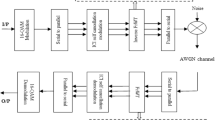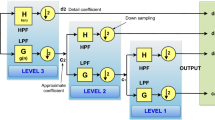Abstract
In this work, propositions to enhance the power efficiency of orthogonal frequency division multiplexing (OFDM) have been investigated, which has been considered as a benchmark for the new generation of ultra-wideband wireless systems; multiband (MBOFDM) has been taken into consideration. Three main propositions have been used to check the system’s performance and to achieve a complexity reduction by making use of the discrete wavelet transform (DWT), a transmission power probability reduction by changing the power constellation of the generated OFDM symbol, a bit error rate enhancement by optimizing the amplitude phase shift keying as a modulation technique. To investigate the propositions’ performances, both of the complementary cumulative distribution function (CCDF) and bit error rates curves have been simulated based on MATLAB. This is in addition to discuss the used power amplifier’s efficiency based on the average mutual information factors, energy efficiency and the achievable information rate (AIR). The simulation results show hybrid work (DWT combined to the power constellations reallocation) gives the best results among the examined work structures; it enhances the CCDF value by 42.4%. Furthermore, it enhances the frame error rate (AIR) to reach the value of \(8.2 \times 10^{-4}\).












Similar content being viewed by others
References
FCC. (2004). First report and order, revision of part 15 of the commission’s rules regarding ultrawideband transmission systems. Technical Report.
Rappaport, T., Sun, S., Mayzus, R., Zhao, H., Azar, Y., Wang, K., et al. (2013). Millimeter wave mobile communications for 5G cellular: It will work!. IEEE Access, 1, 335–349.
Study on new Radio Access Technology Physical Layer Aspects (Release 14). (2017). Document TR 38.802. V14.1.0, 3rd Generation partnership project; Technical Specifications Group Radio Access Network.
Prasad, R. (2004). OFDM for wireless communications systems. Norwood, MA: Artech House.
Nee, V., & Prasad, R. (2000). OFDM wireless multimedia communications. Boston: Artech House.
Bhaskar, V., & Devi, P. A. (2013). Performance of multiband orthogonal frequency division multiplexing network in ultra-wideband channels incorporating people shadowing and channel fading. IET Communications, 7(15), 1665–1675.
Shwartz, M. (2005). Mobile wireless communications. Cambridge: Cambridge University Press.
Han, S. H., & Lee, J. H. (2005). An overview of peak-to-average power ratio reduction techniques for multicarrier transmission. IEEE Wireless Communications, 12(2), 56–65.
Wang, N. L., & Tellambura, C. (2006). An overview of peak-to-average power ratio reduction techniques for OFDM systems. In Proceedings of the IEEE international symposium on signal processing and information technology (pp. 840–845).
Jiang, T., & Wu, Y. (2008). An overview: Peak-to-average power ratio reduction techniques for OFDM signals. IEEE Transactions on Broadcasting, 54(2), 257–268.
Lim, D. W., Heo, S. J., & No, J. S. (2009). An overview of peak-to-average power ratio reduction schemes for OFDM signals. Journal of Communications and Networks, 11(3), 229–239.
Ochiai, H. (2013). An analysis of band-limited communication systems from amplifier efficiency and distortion perspective. IEEE Transactions on Communication, 61(4), 1460–1472.
Rashwan, G., Kenshi, S., & Matin, M. (2017). Analysis of PAPR hybrid reduction technique based on PTS and SLM. In The 7th IEEE annual computing and communication workshop and conference (CCWC) (pp. 1–4).
Mhatre, K. P., & Khot, U. P. (2016). The combined scheme of selective map** and clip** for PAPR reduction of OFDM. In The 3rd international conference on computing for sustainable global development (INDIACom) (pp. 1448–1452).
Han, S., & Lee, J. (2005). An overview of peak-to-average power ratio reduction techniques for multicarrier transmission. IEEE Wireless Communications, 12(2), 56–65.
Krongold, S., & Jones, L. (2003). PAR reduction in OFDM via active constellation extension. IEEE Transactions on Broadcast, 49(3), 258–68.
Jiang, T., & Zhu, G. (2004). OFDM peak-to-average power ratio reduction by complement block coding scheme and its modified version. Vehicular Technology Conference, 1, 448–51.
Lung, S.-Y. (2004). Applied multi-wavelet feature to text independent speaker identification. IEICE Transactions on Fundamentals of Electronics, Communications and Computer Sciences, E87–A(4), 944–945.
Das, S., et al. (2010). Efficacy of multiband OFDM approach in high data rate ultra wideband WPAN physical layer standard using realistic channel models. International Journal of Computer Applications, 2(2), 81–87.
Tran, L., et al. (2010). Quasi-orthogonal space–time-frequency codes in MB-OFDM UWB. Journal Computers & Electrical Engineering, 36(4), 766–774.
Maki, S., Okamoto, E., & Iwanami, Y. (2007). Performance improvement of haar based wavelet packet modulation in multipath fading environment. Sidney: ISCIT.
Emmanuel, A., & Edward, A. (2011). Propagation assessment of MB-OFDM ultra wideband (UWB) MIMO based communication in fading channels. International Journal on Computer Science and Engineering, 1(2), 1–10.
Chang, R. (1966). Synthesis of a band-limited orthogonal signals for multichannel data transmission. The Bell Technical Journal, 45, 1775–1996.
Saltzberg, B. (1967). Performance of an efficient parallel data transmission system. IEEE Transactions on Communications, 15(6), 805–811.
Chan, Y. T. (1995). Wavelet basics. Boston: Kluwer Academic Publishers.
Daoud, O. (2018, February). Multi-bands orthogonal wavelet division multiplexing complexity and power peaks enhancement. IEEE Consumer Electronics Magazine.
Piemontese, A., et al. (2013). Improving the spectral efficiency of nonlinear satellite systems through time–frequency packing and advanced receiver processing. IEEE Transactions on Communications, 61(8), 3404–3412.
Author information
Authors and Affiliations
Corresponding author
Rights and permissions
About this article
Cite this article
Daoud, O.R. Modified Orthogonal Frequency Division Multiplexing Technique: A Candidate for the New Generation of Wireless Systems. Wireless Pers Commun 100, 1047–1061 (2018). https://doi.org/10.1007/s11277-018-5608-6
Published:
Issue Date:
DOI: https://doi.org/10.1007/s11277-018-5608-6




